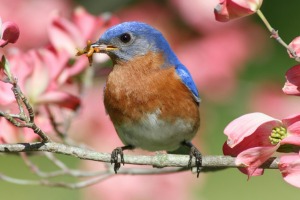 Q: Does anyone have any hints on attracting eastern bluebirds to the yard? They are the prettiest birds, but are seldom seen in the area where I live.
Q: Does anyone have any hints on attracting eastern bluebirds to the yard? They are the prettiest birds, but are seldom seen in the area where I live.Thanks for all replies!
P.J. from Delaware
A: P.J.,
According to the Cornell Lab of Ornithology, Eastern Bluebird populations have been declining in recent years to as low as 17 percent of their previous numbers in the late 50s and 60s. The reasons include competition for nesting, pesticide use and harsh winters. The good news is that their numbers are on the rise in several parts of the country. These birds tend to prefer the country or the suburbs to a noisy city environment, but if you think your backyard is quiet enough, here are some things to try and attract those that may be in the area.
The natural nesting place of Eastern Bluebirds is in tree cavities, especially those hollowed out by woodpeckers. They prefer to have a roof over their heads for nesting, so constructing a few bluebird houses would be a good way to start (there are many free easy-to-make patterns on the web). The Eastern Bluebird's preferred habitat is an open area with short grass and a few trees (this is also the preferred habitat of the House Wren and the House Sparrow, both of which can easily out compete the Eastern for nesting sites). Their diet consists of around 70% of invertebrates-they especially love meal worms.
Good luck!
Ellen
There are several websites that offer tips on attracting the Eastern Bluebird. The main idea is to offer them food, water, and shelter.
'The March return of the Eastern Bluebird is a true sign that spring has arrived. If you live near a field, or any open area including yards, roadsides and even cemeteries, which contains a mix of open spaces and trees, you have a very good chance of attracting a nesting pair to your property.
Eastern Bluebirds originally nested in tree cavities, but suburban growth has dictated the removal of "snags" or dead-limb trees, reducing native nesting habitat.'
(If you don't have the tree cavities available, get or make them a suitable bird house.)
'Eastern Bluebirds are primarily insectivores, ingesting spiders, mealworms, millipedes, caterpillars and other delectable lawn bugs. It is vital to the ongoing health of the bluebird population to provide a pesticide- or chemical-free yard.
During the early spring and late fall, when insects are less plentiful, the bluebirds will dine on sumac seeds and honeysuckle, as well as several types of berries and grapes. They also have been attracted to feeders using nut meats, suet and raisins.
Many people have success attracting bluebirds to specific insectivore feeders.' (info from: www.wildbirdstore.com/
A blueprint for a homemade bluebird nesting box is at: members.tripod.com/
other useful links:
herper.tripod.com/
massbluebird.org/
www.shawcreekbirdsupply.com/
Good luck!
Sabrina
Check out these photos.
This is a Pennsylvania Bluebird. He looks so smart and independent way high on top of my Apricot tree. A quick grabbing of my camera caught the great photo. Hope you enjoy it as much as I did.
While visiting the Antietum Battlefield I was watching a bird in a harvested cornfield and was able to capture it in a picture. To my surprise it was an Eastern Bluebird. I think it turned out to be a very nice scene.
This is a bluebird that has been coming to our house for years. At first we thought a few of them were coming around, but when we noticed this one had broken it's beak off, we realized it was the same one day after day (as it is quite the unique character)!
Although this is not a beautiful photo from a technical standpoint, it captures a sweet moment. During a bout of extreme cold weather, the birds in our yard appreciated our bird bath which is kept thawed by a simple electric de-icer designed for that purpose.
I caught this bluebird posing on a tree in our back yard. He was watching over his little family after he and his mate made their nest in a bird-house nearby.
Bluebirds are indigenous to North America and are prized by birdwatchers and gardeners alike. There are three types of bluebirds; the Eastern and Western are blue with markings in rose, whereas the Mountain bluebird is almost entirely bright blue.